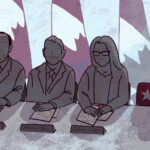As I walked through the hallways of Strathcona High School yesterday afternoon, the unusual quiet was striking. Normally bustling with after-school drama rehearsals and basketball practices, the building stood eerily silent as students filtered out promptly at 3:30.
It’s been three weeks since Edmonton teachers returned to classrooms after their strike action, but the ripple effects continue to reshape student life across the city. While formal instruction has resumed, many teachers are maintaining their withdrawal from voluntary activities like coaching sports teams, directing plays, and supervising clubs.
“We’re caught in this strange limbo,” explains Martin Fitzgerald, a Grade 12 student council president at McNally High School. “Classes are back, but school doesn’t feel like school without all the extras that made it special.”
The Alberta Teachers’ Association (ATA) strike officially ended on February 12th, but teachers’ frustrations remain palpable. Many educators have chosen to continue withholding voluntary services as negotiations with the province continue over issues including class sizes and support for students with complex needs.
For Edmonton’s 213 public and Catholic schools, this ongoing action has created a patchwork of extracurricular offerings that varies widely between schools and even between departments within the same building.
At M.E. LaZerte High School, the spring musical production of “Grease” has been postponed indefinitely, disappointing dozens of student performers who had already begun rehearsals before the strike.
“I’ve been looking forward to this production since Grade 9,” says Aisha Mehta, a Grade 11 student. “For seniors especially, this might have been their last chance to perform on stage before graduation.”
The Edmonton Public School Board has acknowledged these challenges. Spokesperson Sandra Johnson notes that schools are working to identify alternative supervision options where possible.
“We recognize the importance of these activities for student development and mental health,” Johnson told me during a phone interview. “Some schools have been able to engage parents, community volunteers, or non-teaching staff to maintain certain programs.”
At Lillian Osborne High School, a group of dedicated parents has stepped up to ensure the senior girls’ volleyball team can complete their season. Volunteer coach and parent Stephanie Williams admits it’s been challenging.
“We’re doing our best, but we’re not professional coaches. The girls miss the technical expertise their teacher-coaches brought,” Williams explains while watching practice. “Still, we felt it was important they not lose this opportunity completely.”
The impact extends beyond competitive sports. Chess clubs, debate teams, and Gay-Straight Alliances across the city have faced disruption. Many of these groups provide crucial social connections and safe spaces for vulnerable students.
Education Minister Adriana LaGrange has urged teachers to fully resume all activities, calling extracurriculars “vital to the complete educational experience.” However, ATA Local 37 President Heather Quinn defends teachers’ position.
“Edmonton teachers have given thousands of unpaid hours to these activities for years,” Quinn emphasizes. “They’re simply asking for sustainable workloads and appropriate compensation for their professional expertise.”
For senior students applying to post-secondary programs, the timing is particularly concerning. Colleges and universities often consider extracurricular achievements alongside academics when making admissions decisions.
“I was counting on my debate team experience to strengthen my law school application,” says Jasmine Torres, a Grade 12 student at Harry Ainlay High School. “Now our team has essentially dissolved mid-year.”
The Edmonton Arts Council has attempted to fill some gaps by expanding their after-school arts programming. Their “Arts After Hours” initiative now offers additional dance, visual arts, and theatre workshops at community centers throughout the city.
“We can’t replace what schools provide, but we’re trying to ensure students still have creative outlets,” explains Roberto Gutierrez, youth programs coordinator.
Edmonton Sport Council has similarly coordinated with community leagues to open more recreational sports opportunities, though competitive team play remains challenging to replicate outside school structures.
Parents are feeling the strain as well. Many working families relied on after-school activities as de facto childcare. Sarah Mbeki, mother of two junior high students, has had to adjust her work schedule.
“I completely support the teachers, but this has definitely created logistical challenges for our family,” she admits. “We’re paying for additional programming we hadn’t budgeted for.”
Some bright spots have emerged. At Victoria School of the Arts, several retired teachers have returned as volunteers to keep certain programs running. And at J. Percy Page High School, senior students have taken leadership roles in maintaining some clubs with minimal teacher supervision.
As contract negotiations continue, the future remains uncertain. The school year calendar marches forward, with important traditions like graduation ceremonies, year-end concerts, and championship tournaments hanging in the balance.
For Edmonton’s 100,000+ students, school life continues in this diminished form – classrooms full but hallways emptier than they should be after the final bell rings.
As I left Strathcona High School yesterday, I noticed a hand-drawn poster in a window: “We miss our clubs and teams.” It’s a sentiment echoed in schools across Edmonton as this unusual school year continues to unfold.




